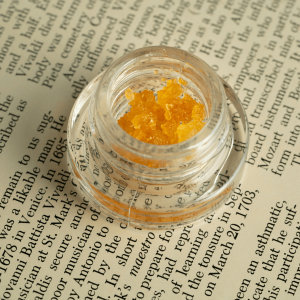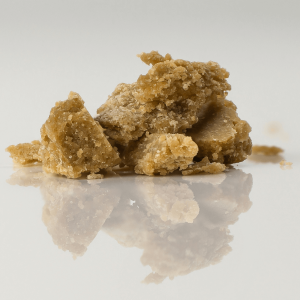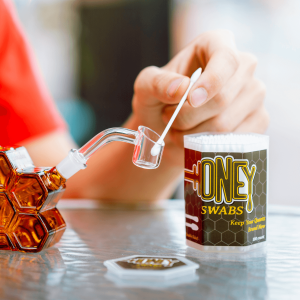Cannabis concentrates have soared in popularity, offering a pure and potent experience compared to traditional forms of consumption. Among these concentrates, weed wax stands out due to its high THC content, providing users with a more intense and rapid onset of effects — but what is weed wax?
This guide will explore weed wax, diving into its production process, the various ways it can be consumed, and essential safety tips every user should know.
Whether you’re a seasoned connoisseur or new to the world of weed, our comprehensive overview will equip you with everything you need to know about weed wax.
What Exactly is Weed Wax?
Cannabis wax is a type of cannabis concentrate known for its high THC (Tetrahydrocannabinol) content, typically ranging from 70% to 90%. This makes it significantly more potent than traditional flower or other forms of concentrates.
The production of wax involves the extraction of THC using solvents like butane or CO2, resulting in a sticky, wax-like substance that showcases its golden to amber coloration. An example of this type of wax would be butane hash oil (BHO).
Unlike other cannabis products, weed wax differentiates itself not just in potency but in texture and consumption methods. It is denser and more concentrated than its counterparts, such as oils, tinctures, or edibles, offering a unique and intense experience.

The Production Process of Weed Wax
The production of weed wax is an intricate process that requires expertise and precision.
It begins with the extraction of THC using solvents like butane or CO2, a method known as solvent-based extraction. This process involves passing the solvent through cannabis plant material to strip it of its cannabinoids and terpenes, which are then collected and concentrated into wax form.
On the other hand, solventless methods, such as using heat and pressure (rosin technology) or ice water extraction, offer a purer and more natural alternative but are less commonly used for wax production due to their lower yield.
Safety is an important concern in the production of marijuana wax concentrates; solvent-based methods pose risks of explosion if not conducted in a controlled, professional environment. With that being said, it is highly recommended that the production of weed wax is left to professionals in well-equipped facilities to ensure the safety of both the producers and the consumers.
Types of Weed Wax
Cannabis wax isn’t one-size-fits-all; it offers different textures to match various preferences and consumption methods. The top picks include budder, crumble, and shatter.
- Budder: Known for its creamy, butter-like consistency, budder is one of the more versatile types of weed wax. Its malleable texture makes it easy to handle and consume, often preferred for dabbing or vaping. Despite its softness, budder retains a high potency that rivals other forms of concentrates.
- Crumble: True to its name, crumble has a drier, more brittle texture compared to other types of marijuana wax. It can easily crumble into a powdery form, which makes it a favorite for adding to joints or bowls for an extra kick. Crumble’s unique texture is a result of its production process, where it is purged of the solvent at a lower temperature for a longer period.
- Shatter: Shatter is distinguishable by its translucent, glass-like appearance. It is perhaps the most potent form of weed wax, boasting not only a high THC concentration but also a long shelf life due to its stable structure. Shatter breaks easily, as its name suggests, and is consumed primarily through dabbing. Its transparent quality is a testament to the purity and careful process of extraction and cooling.
While budder, crumble, and shatter all provide a potent experience, their differences in texture affect their methods of consumption.
Budder and crumble are easier to handle and versatile, suitable for a range of consumption methods, from dabbing to mixing with traditional flower. Shatter, due to its brittle nature, is more commonly consumed through dabbing, offering a clean, pure hit that stoners deeply appreciate.
Each type provides a distinct way to enjoy the strong potency and rich flavors of marijuana wax, suiting individual tastes and consumption styles.

How to Consume Weed Wax
Cannabis wax can be enjoyed in different ways, suiting various preferences and convenience levels.
Popular methods include dabbing, vaporizing, and adding it to edibles and topicals. Knowing the right equipment and processes for each method ensures a safe and fun experience!
Dabbing
Dabbing is the most common method for consuming weed wax because it is known for its efficiency in delivering intense effects.
Equipment needed for dabbing:
- A dab rig, which is similar to a bong but specifically designed for concentrates.
- A nail or banger, typically made from quartz, titanium, or ceramic, where the wax is vaporized.
- A dabber tool, used to apply the wax to the nail.
- A torch, to heat the nail to the right temperature.
- Optional: a carb cap, to cover the nail and regulate airflow.
Step-by-step process:
- Heat the nail with your torch until it’s red-hot.
- Allow it to cool for a bit to achieve the optimal temperature (which depends on your preference but is usually around 350-400°F).
- Use your dabber tool to apply a small amount of marijuana wax onto the nail.
- Inhale slowly as the wax vaporizes.
- Optionally, cover the nail with a carb cap to maximize vapor inhalation.
- Exhale and enjoy.
Vaporizing
Another great way to enjoy weed wax is through a vaporizer made for concentrates. Portable vape pens are super handy, and some models even let you control the temperature precisely, making the wax taste better and more efficient. Just put a bit of wax in, pick your temp, and breathe in the vapor.
Other methods: Edibles, Topicals
- Edibles: For those who prefer not to inhale, infusing weed wax into edibles is an effective alternative. Since wax is highly concentrated, it’s important to start with a small amount and understand how it affects you over time. The wax needs to be decarboxylated first before cooking to activate the THC.
- Topicals: Weed wax can also be used to create topicals, such as lotions or balms, for pain relief. This method doesn’t produce psychoactive effects but can offer localized relief from pain, inflammation, or skin conditions.
Each consumption method offers a unique experience with weed wax, allowing users to enjoy its potent effects in the way that best suits their lifestyle and preferences.

The Benefits of Using Weed Wax
The popularity of weed wax goes beyond its various textures and forms; it’s about the amazing experience it offers to stoners who want to elevate their smoke sesh.
One of its best features is its extra potency, bringing quicker and more intense effects than regular marijuana flower. This means you can reach your desired effects with less product, making it a smart choice both economically and functionally.
Beyond its recreational uses, weed wax also offers great medical benefits, especially for patients needing high cannabinoid doses to manage their conditions.
For these individuals, the concentrated form of weed wax provides invaluable relief, allowing for precise dosing and the potential for immediate therapeutic effects.
This combo of efficiency and effectiveness makes weed wax a standout option in the cannabis world.
Potential Risks and Drawbacks
While the potency of weed wax provides many benefits, it also poses a higher risk of overconsumption, especially for inexperienced users.
The concentrated form means that a small amount goes a long way, and without careful dosage, it’s easy to consume more THC than intended, leading to uncomfortable effects such as paranoia or extreme sedation.
Additionally, the production process of weed wax involves solvents like butane, which, if not properly purged, can leave harmful residues that pose health risks when inhaled.
How to Store and Handle Weed Wax
Properly storing and handling weed wax is key to keeping its potency intact and preventing it from degrading.
For the best storage, try keeping your wax concentrates in a cool, dark spot – think airtight glass or silicone containers. These materials won’t interfere with the concentrate, ensuring your wax stays fresh.
When you’re working with weed wax, grab a dab tool to keep your concentrate clean and avoid wasting any excess product. Additionally, always make sure your hands are squeaky clean to avoid any bacteria spreading across the wax.

Conclusion
In wrapping up our deep dive into the world of weed wax, it’s pretty clear that this potent cannabis concentrate offers a unique and powerful experience for both recreational and medical users.
Understanding the different textures, methods of consumption, and how to properly store and handle weed wax is crucial for maximizing its benefits while minimizing risks. Always start with a low dose, especially if you’re new to concentrates, to gauge your tolerance.
Remember, the key to a positive experience lies in responsible use and continuous education.
As the cannabis industry evolves, staying informed about safe consumption practices and the latest advancements will ensure that your concentrate smoke sessions are enjoyable.
Frequently Asked Questions
1. What is weed wax?
Weed wax is a highly concentrated form of cannabis that is known for its high THC content.
It is made by extracting the THC and other cannabinoids using a solvent, resulting in a wax-like substance with a sticky consistency that delivers potent effects.
2. What’s the difference between wax and bud weed?
The main difference between wax and bud weed (flower) is the concentration of THC.
Wax is much more concentrated, offering higher levels of THC in a smaller amount, whereas bud weed contains THC within the plant’s flowers, requiring more product to achieve similar effects.
Smoking wax tends to offer a more potent experience.
3. What is wax slang for?
In the context of cannabis, “wax” is slang for a type of marijuana concentrate that has a waxy texture. This term is used due to its appearance and consistency, differentiating it from other forms of concentrates like oil or shatter.
4. Is wax better than cart weed?
Whether wax is “better” than cartridge (cart) weed depends on personal preference and the desired experience.
Wax tends to offer a more potent and immediate effect, while carts provide convenience and ease of use, particularly for vaping on the go.
5. Is wax better than flower weed?
Much like comparing wax to cart weed, whether cannabis wax is better than cannabis flower, or leaf marijuana, depends on the user’s preferences.
Wax offers a more intense experience due to its higher THC concentration, making it appealing for those seeking strong effects.
Flower weed, on the other hand, might be preferable for those who enjoy the traditional experience of smoking and the natural flavor profiles of cannabis.

 Rewards
Rewards





